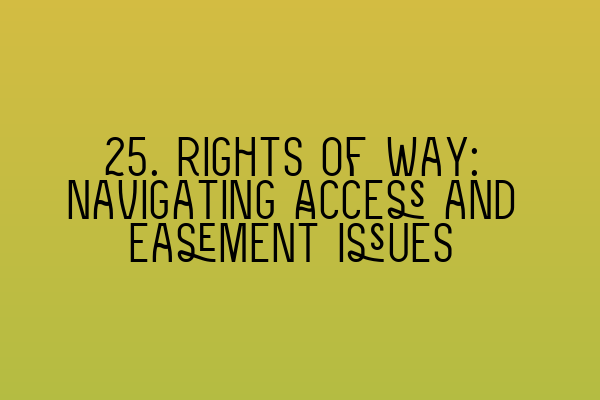25. Rights of Way: Navigating Access and Easement Issues
When it comes to property law, rights of way and easements are crucial aspects to consider. Whether you are a property owner or a land developer, understanding your rights and obligations related to access and easements is essential. In this blog post, we will explore the ins and outs of rights of way, navigating access and easement issues.
What is a Right of Way?
A right of way is a legal easement that gives a person or entity the right to pass through another person’s property. This right ensures that the property owner or a specific group has access to a particular area or road that would otherwise be inaccessible.
There are several types of rights of way, including public rights of way, private rights of way, and implied rights of way.
A public right of way is a path or route that the public has a legal right to access. These are usually designated paths or roads, such as public footpaths or highways. Public rights of way are protected by law and should be accessible to everyone without obstruction.
On the other hand, a private right of way restricts access to specific individuals or entities. These rights are typically granted through legal agreements or easements, allowing the specified parties to pass through the property for certain purposes.
Implied rights of way arise when there is no formal agreement or legal document explicitly granting the right of way. Instead, the right of way may be presumed based on historical use or custom.
Issues with Rights of Way
While rights of way are intended to facilitate access and ensure the efficient use of properties, disputes and issues can arise. Some common issues include:
- Blocked Access: In some cases, property owners may obstruct or deny access to the right of way, causing disruptions or inconvenience to the parties entitled to use it.
- Overuse or Abuse: Rights of way may be subject to limitations or conditions, such as restrictions on the type or amount of traffic. When these limitations are not respected, it can lead to conflicts and potential legal actions.
- Boundary Disputes: Rights of way often traverse boundary lines, which can result in disagreements between neighboring property owners regarding the exact location and extent of the right of way.
Resolving these issues requires a clear understanding of property law, rights of way, and relevant legal precedents. Consulting with a property law solicitor can help navigate these complex situations and ensure your rights are protected.
Understanding Easements
Alongside rights of way, easements play a crucial role in property law. An easement is a legal right that allows one person to use another person’s property for a specific purpose. The easement holder is granted certain privileges or access, even if the property is owned by someone else.
Similar to rights of way, easements can be public or private, depending on the scope of access granted. Common examples of easements include:
- Utility Easements: Utility companies often have easements to access properties for the installation, maintenance, and repair of utility lines and infrastructure.
- Driveway Easements: In shared or multi-dwelling properties, there may be easements allowing the owners or occupants of one property to traverse another property to reach their driveways or parking areas.
- Conservation Easements: Landowners may grant conservation easements to restrict development on their property, preserving its natural or historic characteristics.
Like any legal right, easements can also result in disputes and complications. It is crucial to understand the terms of the easement, any restrictions or conditions, and how they may impact your property or land development plans.
Resolving Access and Easement Issues
To navigate access and easement issues effectively, it is recommended to seek professional legal advice. At SQE Property Law & Land Law, our team of solicitors specializes in property law and can assist you in resolving an array of access and easement-related matters.
Our solicitors will carefully review the relevant documents, agreements, and legal precedents to ensure your rights are protected. We can provide guidance on negotiating with other parties, preparing legal documentation, and representing you in court if necessary.
Don’t let access and easement issues hinder your property ownership or land development plans. Contact SQE Property Law & Land Law today to discuss your specific situation and find the best way forward.
For more resources on legal exams and preparation courses, check out the following articles:
